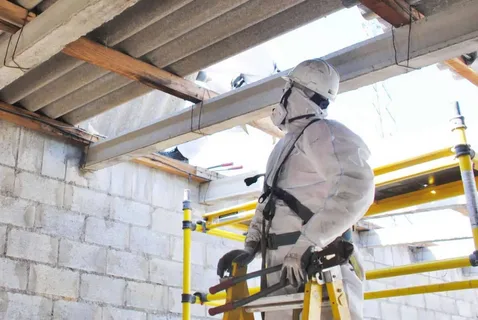Ever heard of asbestos? The material-known as asbestos-hides throughout older homes because builders originally praised this material for its fireproof abilities and durability. The substance used to be valued in construction development has evolved into a dangerous health threat today. Yikes. The construction date of your house before 1980 indicates a high possibility that asbestos sneaks into your home without detection. Asbestos inspections hold such strong importance that they must be considered essential because they protect your health. Conscious knowledge about your home materials may secure the health of your respiratory system.
🔍 Understanding Asbestos Inspection
Certified professionals use thorough asbestos inspections to identify all asbestos-containing materials (ACMs) in buildings. The inspection process includes testing and laboratory examinations with risk evaluation assessments.
The condition of asbestos materials in good state presents a lower hazard risk. Bitumen from asbestos materials becomes airborne whenever structural disturbances occur, such as renovations or water leaks or through normal deterioration. Those tiny fibers that drift through the air will simultaneously enter the respiratory system after being airborne.
Regular routine house inspections do not detect asbestos material in homes. Only specialists who hold the necessary equipment and hold proper certification, together with required competence, can execute professional asbestos removal.
💥 Why You Need Asbestos Inspection
Health Risks Associated with Asbestos
- Lung Diseases: Asbestos fibers which enter your lungs stay trapped inside them. Young fibers that enter your lungs through the air will later form scars that interrupt your breathing system.
- Cancer: Standards reveal that cancer development typically results from mesothelioma which is a rare but fatal cancer form because of asbestos exposure. It’s linked directly to asbestos.
- Other Illnesses: Asbestos exposure may result in pleural plaques together with laryngeal cancer and ovarian cancer as additional health issues.
Common Places Asbestos Hides
- Insulation: Attack and wall cavities and undersides of buildings contain insulation as one of its locations.
- Flooring: Old-school materials such as vinyl tiles and linoleum flooring as well as the glue needed to secure them represent significant asbestos-containing items.
- Roofing and Siding: Homes of the 40s through 70s had asbestos-containing corrugated roofing and siding materials as roofing sheets and siding shingles.
- Pipes and Boilers: The major red flag when it comes to asbestos identification lies in heating ducts and boiler insulation which are wrapped in asbestos material.
Legal and Financial Implications
- Property Value: Home buyers avoid purchasing properties containing asbestos which leads to decreased property value in the market.
- Renovation Delays: Technical workers must cease construction activities whenever they discover unexpected asbestos content according to legal rules.
- Legal Requirements: Real estate activities in California and New York require pre-permit asbestos clearance inspections for properties
| 📊 Statista Insight: According to a 2023 housing safety report published by Statista Insight approximately 56% of the homes constructed before 1980 contain one or multiple asbestos materials. That’s millions of properties! |
| 🧠 Fun Fact + Real ExampleInteresting Fact: Federal laws under the U.S. EPA authorized most asbestos product bans nationwide in 1989 yet a few exceptions remained. Roofing felt as well as particular adhesives remain authorized for sale although both are dangerous for human exposure.Example: During home renovation work in Ohio a married couple discovered asbestos contained in their ceiling tiles. Construction delays because of this mistake cost them both increased expenses amounting to $5,000 and wasted two months of project time. Did the absence of an initial inspection stop them? The properties could have escaped this entire asbestos contamination problem. |
Conclusion
In a nutshell, Making an important decision about asbestos inspections should never be regarded as a shot in the dark. Receiving such an inspection produces vital security for your property investment and personal health protection. Doctors advise proceeding with an older home asbestos inspection because obtaining peace of mind during construction, renovation or habitation of such homes justifies the financial investment. Delaying an inspection before your remodeling project will result in negative consequences that create more dust than expected. Take preventative action to secure your safety while getting the inspection process completed.
FAQs
1. What is asbestos?
Construction projects used to include asbestos a heat-resistant mineral until its history of danger became known. The substance presents a serious risk once disturbed and breathed into the lungs.
2. Do all older residences contain asbestos?
The majority of pre-1980 buildings contain asbestos among their structures. An examination proves the necessary evidence to confirm its presence.
3. If asbestos exists in the property, what will be the next course of action?
A certified abatement crew needs to perform safe procedures for asbestos removal or sealing. Never attempt DIY removal.
4. Is it secure to continue living under asbestos materials that remain undisturbed?
Usually yes—but it’s a gamble. Air fibers potentially enter your breathing space when any type of damage occurs to the material.
5. Does the cost of traditional asbestos inspection services fall between $250 and $800?
Homeowners need to consider spending between $250 and $800 based on house dimensions and geographical area. Certain home inspectors combine their home assessment with asbestos examination in a single service package.

